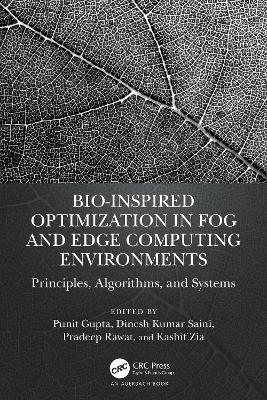
Bio-Inspired Optimization in Fog and Edge Computing Environments
Auerbach (Verlag)
978-1-032-34589-5 (ISBN)
A new era of complexity science is emerging, in which nature- and bio-inspired principles are being applied to provide solutions. At the same time, the complexity of systems is increasing due to such models like the Internet of Things (IoT) and fog computing. Will complexity science, applying the principles of nature, be able to tackle the challenges posed by highly complex networked systems?
Bio-Inspired Optimization in Fog and Edge Computing: Principles, Algorithms, and Systems is an attempt to answer this question. It presents innovative, bio-inspired solutions for fog and edge computing and highlights the role of machine learning and informatics. Nature- or biological-inspired techniques are successful tools to understand and analyze a collective behavior. As this book demonstrates, algorithms, and mechanisms of self-organization of complex natural systems have been used to solve optimization problems, particularly in complex systems that are adaptive, ever-evolving, and distributed in nature.
The chapters look at ways of enhancingto enhance the performance of fog networks in real-world applications using nature-based optimization techniques. They discuss challenges and provide solutions to the concerns of security, privacy, and power consumption in cloud data center nodes and fog computing networks. The book also examines how:
The existing fog and edge architecture is used to provide solutions to future challenges.
A geographical information system (GIS) can be used with fog computing to help users in an urban region access prime healthcare.
An optimization framework helps in cloud resource management.
Fog computing can improve the quality, quantity, long-term viability, and cost-effectiveness in agricultural production.
Virtualization can support fog computing, increase resources to be allocated, and be applied to different network layers.
The combination of fog computing and IoT or cloud computing can help healthcare workers predict and analyze diseases in patients.
Dr. Punit Gupta is currently working as associate professor in the department of computer and communication engineering at Manipal University Jaipur, India. Dr. Dinesh Kumar Saini is a full professor at the School of Computing and Information Technology, Manipal University. Dr. Pradeep Rawat is affiliated with DIT University, India. Dr. Kashif Zia is currently working as an associate professor in the faculty of computing and information technology, Sohar University, Oman.
1. Introduction to Optimization in Fog Computing. 2. Open Issues and Challenges in Fog and Edge. 3. Future Challenges of Fog and Edge Computing Applications. 4. Geographic Information Systems-Based Modeling of Healthcare Data and its Optimization using Various Approaches. 5. Application of Optimization Techniques in Cloud Resource Management. 6. Use of Fog Computing in Healthcare. 7. Fog Computing for Agriculture Application and its Issues. 8. Fog Computing and Vehicular Networks for Smart Traffic Control: Fog Computing-Based Cognitive Analytics Model for Smart Traffic Control. 9. Virtualization Concepts and Industry Standards in Cloud Computing. 10. Optimized Cloud Storage Data Analysis using the Machine Learning Model. 11. Resource Management in Fog Computing Environment using Optimal Fog Network Topology. 12. Applications of Fog in Healthcare Services. 13. Roles and Future of Internet of Things-Based Smart Healthcare Models.
| Erscheinungsdatum | 11.09.2024 |
|---|---|
| Zusatzinfo | 97 Line drawings, black and white; 97 Illustrations, black and white |
| Verlagsort | London |
| Sprache | englisch |
| Maße | 156 x 234 mm |
| Gewicht | 494 g |
| Themenwelt | Mathematik / Informatik ► Informatik ► Netzwerke |
| Informatik ► Theorie / Studium ► Algorithmen | |
| Mathematik / Informatik ► Informatik ► Web / Internet | |
| Informatik ► Weitere Themen ► Hardware | |
| ISBN-10 | 1-032-34589-6 / 1032345896 |
| ISBN-13 | 978-1-032-34589-5 / 9781032345895 |
| Zustand | Neuware |
| Haben Sie eine Frage zum Produkt? |
aus dem Bereich


